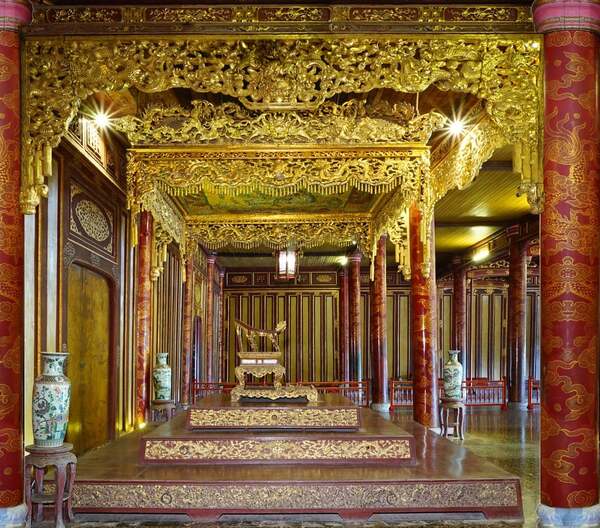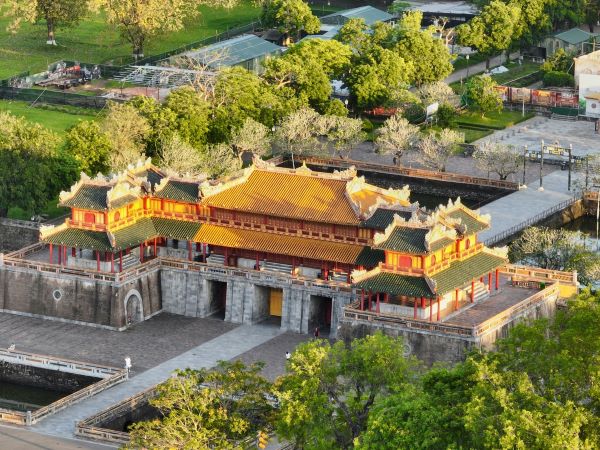Thai Hoa Palace in Hue, Vietnam, is not just an architectural masterpiece but also a cultural symbol of the Nguyen Dynasty. Recently reopened after a three-year restoration, the palace now welcomes visitors to immerse themselves in Vietnam’s imperial heritage. This blog provides a detailed guide to Thai Hoa Palace, including its history, architecture, and travel tips to make your visit memorable.
1. Introduction to Thai Hoa Palace in Hue, Vietnam
Thai Hoa Palace, known as the “Palace of Supreme Harmony,” is one of the most iconic structures in Hue’s Imperial City. Constructed in 1805 under Emperor Gia Long, the palace served as the main ceremonial hall where emperors conducted important events, including coronations and receptions for foreign ambassadors.
This magnificent building is part of Hue’s Complex of Monuments, a UNESCO World Heritage Site, and stands as a testament to Vietnam’s rich history and royal traditions.
2. Why Visit Thai Hoa Palace?
Thai Hoa Palace is a must-visit for history enthusiasts, architecture lovers, and anyone captivated by Vietnam’s imperial past. Here’s why:
A Symbol of Imperial Power
The palace was the heart of the Nguyen Dynasty, reflecting the grandeur of Vietnam’s last royal family. Visiting this site offers a glimpse into the rituals and governance of the Nguyen emperors.
A Masterpiece of Vietnamese Architecture

Thai Hoa Palace still retains the architectural features of ancient Vietnamese dynasties.
From the intricate woodwork to the vibrant lacquered pillars, the palace showcases the finest craftsmanship of its time.
A Unique Experience After Restoration
The recent restoration has brought the palace back to its former glory, preserving its historical authenticity while enhancing its structural integrity.
3. Exploring the Architecture and Interior of Thai Hoa Palace
The Grand Exterior
As you approach the palace, you’ll be greeted by its imposing facade adorned with traditional motifs of dragons and phoenixes, symbolizing power and prosperity. The roof, made of glazed tiles, reflects the royal status of the building.
The Majestic Interior
Step inside Thai Hoa Palace to admire its exquisite details:
- Golden Columns: 80 lacquered wooden columns support the structure, each intricately carved and painted in red and gold.
- Dragon Motifs: Dragons, symbols of the emperor’s divine power, are intricately carved into beams and pillars.
- Throne Room: At the center of the palace lies the emperor’s throne, surrounded by decorative screens and royal insignias.

The emperor’s throne is located at the center of the palace, flanked by decorative screens and royal insignias.
A Space of Harmony
The palace was designed following the principles of Feng Shui, creating a harmonious flow between the structure and its surroundings.
4. What to Know Before You Visit
Opening Hours and Entrance Fees
- Hours: Thai Hoa Palace is open daily from 7:00 AM to 5:30 PM.
- Ticket Price: Admission is included in the Imperial City ticket, which costs approximately $8 (200,000 VND) for adults.
Visitor Guidelines
- Dress modestly to respect the cultural significance of the site.
- Avoid touching the artifacts to help preserve their condition.
- Photography is allowed but without flash.
5. Best Time to Visit Thai Hoa Palace
The ideal time to explore Thai Hoa Palace and Hue’s Imperial City is during the dry season (March to August). The clear skies and warm weather make it easier to explore the expansive grounds. Early mornings or late afternoons are recommended to avoid crowds and enjoy cooler temperatures.

Rain in Hue (photo: Doan Quang)
6. How to Get to Thai Hoa Palace in Hue, Vietnam
By Air
Fly to Phu Bai International Airport in Hue, which is about 15 kilometers from the city center.
By Train
Take the Reunification Express train to Hue Station, which is well-connected to major cities like Hanoi and Ho Chi Minh City.
By Road
Buses and private transfers are available from nearby cities like Da Nang (100 kilometers away).
Once in Hue, you can easily reach Thai Hoa Palace by cyclo, taxi, or motorbike.
7. Nearby Attractions in Hue’s Imperial City
Make the most of your visit by exploring other landmarks within the Imperial City:
- Ngo Mon Gate: The main entrance to the Imperial City, an architectural marvel in its own right.
- Forbidden Purple City: The former royal residence, once reserved exclusively for the emperor and his family.
- The Nine Dynastic Urns: A set of bronze urns representing the strength and unity of Vietnam.
Read more: 48 Hours Hue: Top Attractions, Local Food, and Travel Tips

Ngo Mon Gate, Imperial Citadel, Hue
8. Tips for a Memorable Visit
- Hire a Guide: A knowledgeable guide can provide fascinating insights into the history and significance of Thai Hoa Palace.
- Bring Water and Sunscreen: Exploring Hue can be tiring under the sun, so stay hydrated and protected.
- Combine with Local Cuisine: After your visit, enjoy Hue’s culinary delights, such as Bun Bo Hue or Banh Beo.
Read more: 5 Must-try Foods When You Visit Hue
Visiting Thai Hoa Palace in Hue, Vietnam, is like stepping back in time to an era of imperial glory and cultural sophistication. As a must-see landmark, it stands as a compelling reason to visit Hue, a city rich in historical and cultural treasures. Whether you’re drawn by its historical significance, architectural beauty, or recently restored splendor, Thai Hoa Palace promises a journey you’ll never forget.
At Paradise Travel, we offer personalized tours to help you uncover the best of Hue’s historical and cultural treasures. From expert guides to curated itineraries, we ensure an unforgettable experience. Plan your trip now and let Paradise Travel guide you through the heart of Vietnam’s royal heritage.














